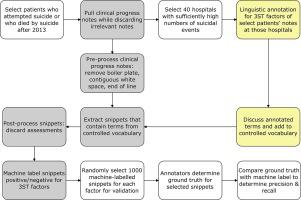Journal of Biomedical informatics ( IF 4.5 ) Pub Date : 2023-12-30 , DOI: 10.1016/j.jbi.2023.104582 Esther L. Meerwijk , Gabrielle A. Jones , Asqar S. Shotqara , Sofia Reyes , Suzanne R. Tamang , Hyrum S. Eddington , Ruth M. Reeves , Andrea K. Finlay , Alex H.S. Harris

|
Objective
Suicide risk prediction algorithms at the Veterans Health Administration (VHA) do not include predictors based on the 3-Step Theory of suicide (3ST), which builds on hopelessness, psychological pain, connectedness, and capacity for suicide. These four factors are not available from structured fields in VHA electronic health records, but they are found in unstructured clinical text. An ontology and controlled vocabulary that maps psychosocial and behavioral terms to these factors does not exist. The objectives of this study were 1) to develop an ontology with a controlled vocabulary of terms that map onto classes that represent the 3ST factors as identified within electronic clinical progress notes, and 2) to determine the accuracy of automated extractions based on terms in the controlled vocabulary.
Methods
A team of four annotators did linguistic annotation of 30,000 clinical progress notes from 231 Veterans in VHA electronic health records who attempted suicide or who died by suicide for terms relating to the 3ST factors. Annotation involved manually assigning a label to words or phrases that indicated presence or absence of the factor (polarity). These words and phrases were entered into a controlled vocabulary that was then used by our computational system to tag 14 million clinical progress notes from Veterans who attempted or died by suicide after 2013. Tagged text was extracted and machine-labelled for presence or absence of the 3ST factors. Accuracy of these machine-labels was determined for 1000 randomly selected extractions for each factor against a ground truth created by our annotators.
Results
Linguistic annotation identified 8486 terms that related to 33 subclasses across the four factors and polarities. Precision of machine-labeled extractions ranged from 0.73 to 1.00 for most factor-polarity combinations, whereas recall was somewhat lower 0.65–0.91.
Conclusion
The ontology that was developed consists of classes that represent each of the four 3ST factors, subclasses, relationships, and terms that map onto those classes which are stored in a controlled vocabulary (https://bioportal.bioontology.org/ontologies/THREE-ST). The use case that we present shows how scores based on clinical notes tagged for terms in the controlled vocabulary capture meaningful change in the 3ST factors during weeks preceding a suicidal event.
中文翻译:

发展自杀本体论的三步理论,以促进从临床进展记录中提取第三步因素
客观的
退伍军人健康管理局 (VHA) 的自杀风险预测算法不包括基于自杀三步理论 (3ST) 的预测因素,该理论建立在绝望、心理痛苦、关联性和自杀能力的基础上。这四个因素无法从 VHA 电子健康记录的结构化字段中获得,但可以在非结构化临床文本中找到。将心理社会和行为术语映射到这些因素的本体论和受控词汇并不存在。本研究的目标是 1) 开发一个具有受控术语词汇表的本体论,该词汇表映射到代表电子临床进展记录中确定的 3ST 因素的类别,以及 2) 确定基于术语的自动提取的准确性受控词汇。
方法
由四名注释者组成的团队对 VHA 电子健康记录中 231 名试图自杀或自杀身亡的退伍军人的 30,000 条临床进展记录进行了语言注释,其中包含与 3ST 因素相关的术语。注释涉及手动为单词或短语分配标签,以指示该因素是否存在(极性)。这些单词和短语被输入到受控词汇表中,然后我们的计算系统使用该词汇表来标记 2013 年后试图自杀或自杀身亡的退伍军人的 1400 万份临床进展笔记。标记文本被提取并通过机器标记是否存在第三因素。这些机器标签的准确性是根据我们的注释者创建的基本事实,针对每个因素随机选择 1000 个提取结果来确定的。
结果
语言注释识别出 8486 个术语,与四个因素和极性的 33 个子类相关。对于大多数因子极性组合,机器标记提取的精确度范围为 0.73 至 1.00,而召回率稍低,为 0.65-0.91。
结论
开发的本体由代表四个 3ST 因素、子类、关系和术语的类组成,这些类映射到存储在受控词汇表中的类(https://bioportal.bioontology.org/ontologies/THREE-英石)。我们展示的用例显示了基于受控词汇中标记的术语的临床记录的分数如何捕获自杀事件前几周内 3ST 因素的有意义的变化。



























 京公网安备 11010802027423号
京公网安备 11010802027423号